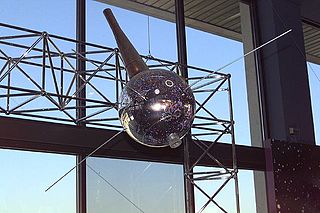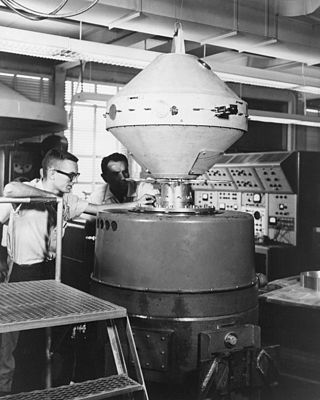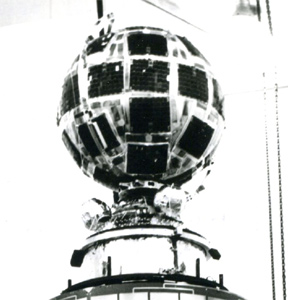
Vanguard 1 is an American satellite that was the fourth artificial Earth-orbiting satellite to be successfully launched, following Sputnik 1, Sputnik 2, and Explorer 1. It was launched 17 March 1958. Vanguard 1 was the first satellite to have solar electric power. Although communications with the satellite were lost in 1964, it remains the oldest human-made object still in orbit, together with the upper stage of its launch vehicle.

Vanguard 2 is an Earth-orbiting satellite launched 17 February 1959 at 15:55:02 GMT, aboard a Vanguard SLV-4 rocket as part of the United States Navy's Project Vanguard. The satellite was designed to measure cloud cover distribution over the daylight portion of its orbit, for a period of 19 days, and to provide information on the density of the atmosphere for the lifetime of its orbit. As the first weather satellite and one of the first orbital space missions, the launch of Vanguard 2 was an important milestone in the Space Race between the United States and the Soviet Union. Vanguard 2 remains in orbit.

Vanguard 3 is a scientific satellite that was launched into Earth orbit by the Vanguard SLV-7 on 18 September 1959, the third successful Vanguard launch out of eleven attempts. Vanguard rocket: Vanguard Satellite Launch Vehicle-7 (SLV-7) was an unused Vanguard TV-4BU rocket, updated to the final production Satellite Launch Vehicle (SLV).

Project Echo was the first passive communications satellite experiment. Each of the two American spacecraft, launched in 1960 and 1964, were metalized balloon satellites acting as passive reflectors of microwave signals. Communication signals were transmitted from one location on Earth and bounced off the surface of the satellite to another Earth location.

Explorer 32, also known as Atmosphere Explorer-B (AE-B), was a NASA satellite launched by the United States to study the Earth's upper atmosphere. It was launched from Cape Canaveral on a Delta C1 launch vehicle, on 25 May 1966. It was the second of five "Atmosphere Explorer", the first being Explorer 17. Though it was placed in a higher-than-expected orbit by a malfunctioning second stage on its launch vehicle, Explorer 32 returned data for ten months before failing due to a sudden depressurization. The satellite reentered the Earth's atmosphere on 22 February 1985.

Explorer 17 was a NASA satellite, launched at Cape Canaveral from LC-17B on a Delta B launch vehicle, on 3 April 1963, at 02:00:02 GMT, to study the Earth's upper atmosphere. It was the first satellite of five "Atmosphere Explorer".

Explorer 8 was a NASA research satellite launched on 3 November 1960. It was intended to study the temporal and spatial distribution of the electron density, the electron temperature, the ion concentration, the ion mass, the micrometeorite distribution, and the micrometeorite mass in the ionosphere at altitudes between 400 km (250 mi) and 1,600 km (990 mi) and their variation from full sunlit conditions to full shadow, or nighttime, conditions.

C/NOFS, or Communications/Navigation Outage Forecasting System was a USAF satellite developed by the Air Force Research Laboratory (AFRL) Space Vehicles Directorate to investigate and forecast scintillations in the Earth's ionosphere. It was launched by an Orbital Sciences Corporation Pegasus-XL launch vehicle at 17:02:48 UTC on 16 April 2008 and decayed on 28 November 2015.

Explorer 9, known as S-56A before launch, was a NASA satellite which was launched in February 1961 to study the density and composition of the upper thermosphere and lower exosphere. It was a reflight of the failed Explorer S-56 mission, and consisted of a 7 kg (15 lb), 3.66 m (12.0 ft) balloon which was deployed into a medium Earth orbit. The mission was conducted by NASA's Langley Research Center.

Vanguard SLV-5, also called Vanguard Satellite Launch Vehicle-Five hoped to be the third successful flight of the American Vanguard rocket following the successful Vanguard 2 satellite on rocket Vanguard SLV-4.

Explorer S-56 was a NASA satellite launched on 4 December 1960, at 21:14 GMT as part of the Explorer program. The satellite was composed of a 3.66 m (12.0 ft) diameter inflatable sphere, and was intended to study the density of the upper atmosphere. The Scout X-1 rocket used to launch Explorer S-56 failed in flight, and the satellite never reached orbit.

Explorer 27 was a small NASA satellite, launched in 1965, designed to conduct scientific research in the ionosphere. It was powered by 4 solar panels. One goal of the mission was to study in detail the shape of the Earth by way of investigating variations in its gravitational field. It was the third and last of the Beacons in the Explorers program. The satellite was shut off in July 1973 so that its transmission band could be used by higher-priority spacecraft.

Explorer 13,, was a NASA satellite launched as part of the Explorer program on 25 August 1961, at 18:29:44 GMT, from Wallops Flight Facility (WFF), Virginia.

Explorer 22 was a small NASA ionospheric research satellite launched 9 October 1964, part of NASA's Explorer Program. It was instrumented with an electrostatic probe, four radio beacons for ionospheric research, a passive laser tracking reflector, and two radio beacons for Doppler navigation experiments. Its objective was to provide enhanced geodetic measurements of the Earth as well as data on the total electron content in the Earth's atmosphere and in the satellite's immediate vicinity.

Explorer 24 was a NASA satellite designed for atmospheric studies. Explorer 24 was launched on 21 November 1964 from Vandenberg Air Force Base, Lompoc, California, with a Scout X-4. Explorer 24 was launched along with its successor satellite, Explorer 25.

Explorer 39, also known as AD-C, was a NASA scientific satellite belonging to series Air Density. It was launched on 8 August 1968, join with Explorer 40, from Launch Complex 5 of the Vandenberg Air Force Base, through a Scout launch vehicle.

Solrad 10, also known Explorer 44, NRL-PL 165 and Explorer SE-C, was one of the SOLRAD series designed to provide continuous coverage of wavelength and intensity changes in solar radiation in the UV, soft and hard X-ray regions. The satellite also mapped the celestial sphere using a high-sensitivity X-ray detector. Information collected was expected to contribute to a better understanding of the physical processes involved in solar flares and other solar activity, and the potential effects of this activity on short-wave communications, as well as on future human space travel. For the period of July 1971 to June 1973, the core memory data of Explorer 44 were used rather than those from Explorer 37. The Explorer 44 core memory failed on 11 June 1973, and Explorer 37 was heavily used until 25 February 1974, when the gas supply of the attitude control system was exhausted.

Explorer 45 was a NASA satellite launched as part of Explorer program. Explorer 45 was the only one to be released from the program Small Scientific Satellite.

Dual Air Density Explorer was a set of 2 satellites, DADE-A and DADE-B, released as part of NASA's Explorer program. DADE-A and DADE-B was launched on 6 December 1975 at 03:35:01 UTC, by a Scout F-1 launch vehicle from Space Launch Complex 5, Vandenberg Air Force Base, California. The launch of the DADE satellites failed.

Beacon was one of America's first satellite programs. A balloon satellite, its objective was to study atmospheric density at its orbital altitude and to be the first United States satellite visible to the naked eye. Booster problems caused both orbital attempts to end in failure.



















